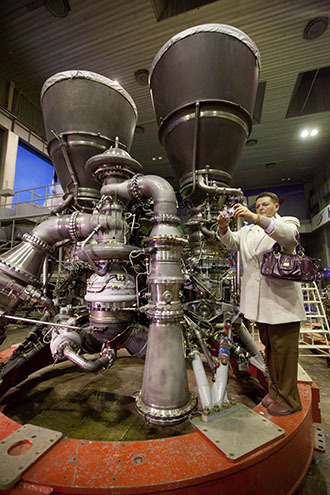The US has launched a military satellite into orbit using an Atlas 5 rocket with a Russian-made engine. Following warnings that non-civilian launches may force Russia to ban delivery, the US Senate approved $100mn in funding to create a US equivalent.
Five minutes into the successful flight, the command center at Cape Canaveral Air Force Station stopped its video feed to disguise the classified payload for the National Reconnaissance Office (NRO).
Powering the 10th Atlas 5 with a cargo from the NRO, for the first four minutes of journey, was a Russian RD-180 liquid-fueled engine.
The two-thrust chamber liquid oxygen/kerosene design was created by NPO Energomash located in Khimky, Russia. US aerospace manufacturer Pratt & Whitney financed the venture to develop RD-180 for the Atlas program.
The engine is capable of producing almost one million pounds of thrust and is “throttled up and down to ease the stresses the rocket experiences throughout the launch,” Space.com says.
“All across the government we thought it was an excellent idea for a variety of reasons to bring in Russian engines, not least because we wanted to understand the technology of a clearly superior engine, and learn how to build it ourselves, and one of the absolute constraints on approval of the deal that the policy-levels of government is that we would learn how to coproduce the engine,” Mike Griffin, the former NASA administrator who participated in US Defense Department study on replacing the RD-180 told Space.com

The engine has been used successfully 51 times on Atlas 3 and Atlas 5 missions since 2000, but the latest tensions surrounding Ukrainian turmoil, and subsequent deterioration in US-Russian relations, forced the US Senate Armed Services Committee to give a green light for $100 million budget to design a new US rocket engine.
In an effort the eliminate reliance on Russian space know-how, the Senate Committee in a $601 billion defense authorization bill included a provision requiring the DoD to produce a medium lift liquid rocket engine no later than 2019.
The US timeline seems to concur with Russia's announcement by Deputy Prime Minister Dmitry Rogozin who earlier in May warned that Russia may ban exports of RD-180s for American military purposes.
“Russia is ready to continue deliveries of RD-180 engines to the US only under the guarantee that they won’t be used in the interests of the Pentagon,” tweeted the head of Russia's defense and space industry.
In light of US imposed sanctions on Russia over Crimea, a US federal judge temporarily barred buying the RD-180, but the ruling was lifted and NPO Energomash was not placed on the sanctions list.
Pratt & Whitney has the license to co-produce the Russian rocket-engine, but American politicians are wary that such an arrangement would still leave Washington dependent on Moscow.
But despite the additional $100 million dollar funding, Defense Department estimates that losing the contract for Russian RD-180 engines would cost up to US $5 billion.
In the so-called Mitchell Report, led by retired Air Force Maj. Gen. Mitch Mitchel, obtained by SpaceNews, “in a best-case scenario, the loss of the RD-180 would mean delaying nine missions for an average of two years, costing taxpayers about $2.5 billion,” the publication writes.
The report's authors recommend the DOD to stock up on more rocket engines before Russia stops supply.
These proposals have been confirmed by Energomash as US plans to buy 37 units instead of the planned 29 by 2018, company's director Vladimir Solntsev told ITAR-TASS.
